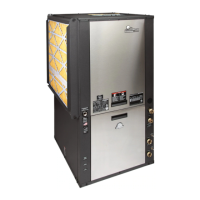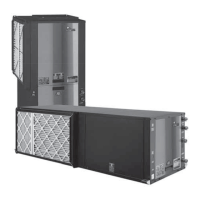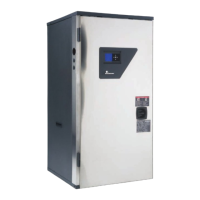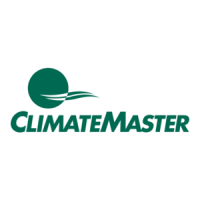Do you have a question about the ClimateMaster tranquility 30 and is the answer not in the manual?
Safety warnings, cautions, and notices for installation, service, or troubleshooting.
Procedures for inspecting the unit shipment for damage or shortages upon delivery.
Guidelines for storing the unit to maintain its condition before installation.
Methods to protect the unit from physical damage and contamination during installation.
Essential steps and checks to perform before commencing unit installation.
Guidelines for properly sizing and installing the duct system for optimal airflow.
Requirements and considerations for selecting an appropriate indoor location for vertical units.
Techniques to reduce noise transmission from vertical units in mechanical rooms or closets.
Considerations for choosing a suitable indoor location for horizontal unit installation.
Instructions and methods for securely mounting horizontal units using hanger kits.
Instructions for converting the air discharge configuration of horizontal units from side to back or vice versa.
Proper methods for pitching and installing condensate drain lines, including trap requirements.
Details on connecting water lines using swivel fittings and gasket seals for residential models.
Overview of various vFlow configurations including Internal Flow Controller and Modulating Motorized Valve options.
Steps for locating and marking underground utilities before installing closed-loop systems.
Recommendations for materials and methods for installing closed-loop ground source piping.
Explanation of the purpose and use of Schrader ports for measuring water pressure drop.
Procedure for filling the loop with water and using the flush cart before flushing.
Steps for filling the heat exchanger with water using the flush cart during the flushing process.
Detailed procedure for flushing the earth loop to remove air and debris, including dead heading.
Steps for pressurizing the loop and preparing the unit for operation after flushing.
How vFlow technology assists in systems with multiple heat pump units.
Describes simple multi-unit systems using internal flow controllers and internal flushing valves.
Guidelines for multi-unit systems requiring external flushing valves due to size or complexity.
Guidelines for selecting appropriate antifreeze based on temperature and local conditions.
Procedures for charging antifreeze into the ground loop system to prevent freezing.
How to set the low water temperature cutout using DXM2 control jumpers for antifreeze.
Details and considerations for open loop systems, including piping materials and water quality.
Requirements for water quality in open loop applications to prevent scaling and corrosion.
Guidelines for selecting and sizing pressure tanks and pumps for open loop applications.
Setting the low temperature limit for water coils in open loop systems to prevent freeze damage.
Steps and considerations for installing the Hot Water Generator (HWG) or desuperheater option.
Configuration of HWG operation using DIP switches on the DXM2 control board.
Procedures for preparing an existing water tank for HWG installation, including draining and flushing.
Guidelines for routing and installing water piping for the Hot Water Generator.
Steps for refilling the water tank and purging air from the HWG piping.
Steps for performing the initial start-up of the HWG system after installation.
Instructions for making the main line voltage connection to the unit's contactor.
Guidelines for ensuring correct line voltage and phase for unit wiring.
Information on factory wiring for 230V operation and how to switch to 208V.
How to connect accessory devices to the DXM2 control via terminal "A" and accessory relays.
Guidelines for locating and wiring thermostats to the DXM2 control board.
Instructions on adjusting CFM settings to achieve rated airflow for AHRI testing purposes.
Configuration, start-up, and operational settings for the DXM2 control system.
How to select the low water temperature cutout setting using JW3 jumper on the DXM2 PCB.
Factors determining operating limits and their effect on unit performance and reliability.
Typical conditions and notes for commissioning the unit, including minimum/maximum limits.
A checklist of critical steps to perform before powering on the unit and system.
Step-by-step guide for initiating the unit's start-up sequence and verifying operation.
Overview of installer settings accessible via the thermostat or diagnostic tool.
How to use manual operation mode for testing and diagnosing unit functions.
Procedures for cleaning and maintaining water coils, HWG coils, filters, and air coils.
Maintenance for condensate drain, compressor, fan motors, cabinet, and refrigerant system.
Preliminary checks, DXM2 board diagnostics, field inputs, and sensor input verification.
Features of the DXM2 control for diagnostics, including outputs, test mode, service mode, and fault history.
A diagnostic flowchart to identify and resolve unit operational problems using the DXM2 control.
Troubleshooting steps for main power, high pressure, and low pressure faults.
Diagnosing faults related to water temperature, air temperature, and condensate levels.
Troubleshooting over/under voltage faults that cause auto-resetting issues.
Diagnosing issues leading to insufficient cooling or heating, including airflow and refrigerant problems.
Troubleshooting causes of high head pressure, such as water flow or refrigerant charge issues.
Diagnosing and resolving issues related to low suction pressure, often linked to airflow or charge.
Troubleshooting low discharge air temperature during heating mode, potentially due to airflow.
Identifying causes of high humidity, possibly related to unit oversizing or airflow.
Troubleshooting when only the compressor is running, indicating issues with fan or thermostat.
Steps to troubleshoot why the unit fails to operate in cooling mode, checking thermostat and reversing valve.
Diagnosing problems with the modulating valve, checking output signals and jumper settings.
How to calculate and record heat of extraction or rejection for performance analysis.
Detailed terms and conditions of the limited express warranty for ClimateMaster residential products.
Safety warnings, cautions, and notices for installation, service, or troubleshooting.
Procedures for inspecting the unit shipment for damage or shortages upon delivery.
Guidelines for storing the unit to maintain its condition before installation.
Methods to protect the unit from physical damage and contamination during installation.
Essential steps and checks to perform before commencing unit installation.
Guidelines for properly sizing and installing the duct system for optimal airflow.
Requirements and considerations for selecting an appropriate indoor location for vertical units.
Techniques to reduce noise transmission from vertical units in mechanical rooms or closets.
Considerations for choosing a suitable indoor location for horizontal unit installation.
Instructions and methods for securely mounting horizontal units using hanger kits.
Instructions for converting the air discharge configuration of horizontal units from side to back or vice versa.
Proper methods for pitching and installing condensate drain lines, including trap requirements.
Details on connecting water lines using swivel fittings and gasket seals for residential models.
Overview of various vFlow configurations including Internal Flow Controller and Modulating Motorized Valve options.
Steps for locating and marking underground utilities before installing closed-loop systems.
Recommendations for materials and methods for installing closed-loop ground source piping.
Explanation of the purpose and use of Schrader ports for measuring water pressure drop.
Procedure for filling the loop with water and using the flush cart before flushing.
Steps for filling the heat exchanger with water using the flush cart during the flushing process.
Detailed procedure for flushing the earth loop to remove air and debris, including dead heading.
Steps for pressurizing the loop and preparing the unit for operation after flushing.
How vFlow technology assists in systems with multiple heat pump units.
Describes simple multi-unit systems using internal flow controllers and internal flushing valves.
Guidelines for multi-unit systems requiring external flushing valves due to size or complexity.
Guidelines for selecting appropriate antifreeze based on temperature and local conditions.
Procedures for charging antifreeze into the ground loop system to prevent freezing.
How to set the low water temperature cutout using DXM2 control jumpers for antifreeze.
Details and considerations for open loop systems, including piping materials and water quality.
Requirements for water quality in open loop applications to prevent scaling and corrosion.
Guidelines for selecting and sizing pressure tanks and pumps for open loop applications.
Setting the low temperature limit for water coils in open loop systems to prevent freeze damage.
Steps and considerations for installing the Hot Water Generator (HWG) or desuperheater option.
Configuration of HWG operation using DIP switches on the DXM2 control board.
Procedures for preparing an existing water tank for HWG installation, including draining and flushing.
Guidelines for routing and installing water piping for the Hot Water Generator.
Steps for refilling the water tank and purging air from the HWG piping.
Steps for performing the initial start-up of the HWG system after installation.
Instructions for making the main line voltage connection to the unit's contactor.
Guidelines for ensuring correct line voltage and phase for unit wiring.
Information on factory wiring for 230V operation and how to switch to 208V.
How to connect accessory devices to the DXM2 control via terminal "A" and accessory relays.
Guidelines for locating and wiring thermostats to the DXM2 control board.
Instructions on adjusting CFM settings to achieve rated airflow for AHRI testing purposes.
Configuration, start-up, and operational settings for the DXM2 control system.
How to select the low water temperature cutout setting using JW3 jumper on the DXM2 PCB.
Factors determining operating limits and their effect on unit performance and reliability.
Typical conditions and notes for commissioning the unit, including minimum/maximum limits.
A checklist of critical steps to perform before powering on the unit and system.
Step-by-step guide for initiating the unit's start-up sequence and verifying operation.
Overview of installer settings accessible via the thermostat or diagnostic tool.
How to use manual operation mode for testing and diagnosing unit functions.
Procedures for cleaning and maintaining water coils, HWG coils, filters, and air coils.
Maintenance for condensate drain, compressor, fan motors, cabinet, and refrigerant system.
Preliminary checks, DXM2 board diagnostics, field inputs, and sensor input verification.
Features of the DXM2 control for diagnostics, including outputs, test mode, service mode, and fault history.
A diagnostic flowchart to identify and resolve unit operational problems using the DXM2 control.
Troubleshooting steps for main power, high pressure, and low pressure faults.
Diagnosing faults related to water temperature, air temperature, and condensate levels.
Troubleshooting over/under voltage faults that cause auto-resetting issues.
Diagnosing issues leading to insufficient cooling or heating, including airflow and refrigerant problems.
Troubleshooting causes of high head pressure, such as water flow or refrigerant charge issues.
Diagnosing and resolving issues related to low suction pressure, often linked to airflow or charge.
Troubleshooting low discharge air temperature during heating mode, potentially due to airflow.
Identifying causes of high humidity, possibly related to unit oversizing or airflow.
Troubleshooting when only the compressor is running, indicating issues with fan or thermostat.
Steps to troubleshoot why the unit fails to operate in cooling mode, checking thermostat and reversing valve.
Diagnosing problems with the modulating valve, checking output signals and jumper settings.
How to calculate and record heat of extraction or rejection for performance analysis.
Detailed terms and conditions of the limited express warranty for ClimateMaster residential products.
| Brand | ClimateMaster |
|---|---|
| Model | tranquility 30 |
| Category | Heat Pump |
| Language | English |












